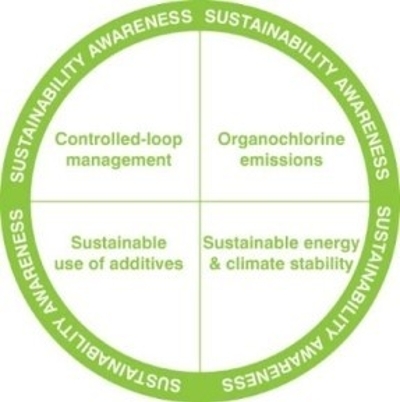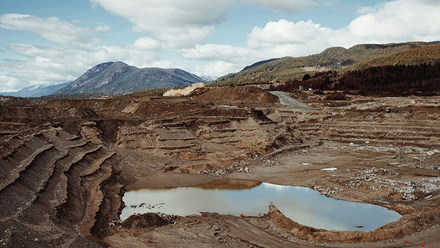A lead on recycling PVC
Dr Mark Everard discusses the need for a rational, science-based, step-by-step approach to tackle legacy constituents when recycling PVC.

No-one is likely to contest the ultimate, and ultimately necessary, ideal of sustainability – a ‘perfect’ situation free of toxic or accumulative substances, ecosystem depletion, or infringements of human rights. This systemic summation is neatly defined in scientific terms by The Natural Step (TNS) – an international NGO.
However, the attainability of that ideal in the immediate or near term is questionable. Sustainable development describes the journey from today’s far from ideal norms towards that ideal goal of full sustainability.
The TNS approach tackles this journey pragmatically through a series of tools, visioning how a process or product might be fully sustainable and assessing current reality against four-linked system conditions for sustainability. Through ‘backcasting’, incremental and attainable steps can be identified towards the ideal goal, rather than reacting to current problems through measures potentially locking investment into blind alleys.
Backcasting also addresses the harsh reality of our current distance from sustainability, and reflects that all incremental steps must be financially sustainable.
The wisdom embedded in the observation by French philosopher Voltaire that ‘Perfection is the enemy of the good’ is pertinent here. Immediate attainment of ‘perfection’ may be practically infeasible but, informed by backcasting, should guide rather than malign ‘good’ sequential and feasible steps, towards the aspirational goal of full sustainability.
Tension points
This conflict is manifest in two European Commission (EC) strategies – Towards a non-toxic environment strategy and Circular economy – implementation of the circular economy action plan. Though influencing thinking about chemical use across Europe, inherent tensions exist between them in terms of resource recovery and the re-entry into recycling streams of ‘problem’ constituents in end-of-life products.
Lead stabilisers in polyvinyl chloride (PVC) products are a topical example. Virtues of PVC include its lightness, low-cost, adaptability and durability, enabling delivery of long-service lives per unit of chemical material with little or no maintenance inputs, and potential recyclability.
As PVC polymer chains are prone to thermal oxidation, it is necessary to incorporate heat stabilisers into virgin PVC. Historically, lead was a constituent of one family of stabilisers. However, lead-based additives were voluntarily substituted with other thermal stabiliser substances across Europe by 2015, as one of many significant outcomes of Europe-wide, voluntary, sustainable development commitments under the VinylPlus programme.
VinylPlus comprises players in the PVC value chain signing up to five interconnected sustainability challenges. As of 2019, close to 800,000 tonnes – roughly one-third of the PVC waste generated in Europe – is now recycled.
For both EC and TNS initiatives, circular use of resources means material and value recovery from end-of-life products. Given the longevity of many PVC products, this inevitably means that lead stabilisers within older formulations comprise part of material flows entering recycling streams.
Lead is not the only additive substance that may now be regarded as problematic. PVC is also far from alone. Many other end-of-life materials may also contain substances now, or potentially in future, regarded as of concern. Furthermore, increasing knowledge of chemical impacts may lead to more substances assumed ‘safe’ today coming under closer scrutiny and concern.
Legacy materials
A purist ‘perfectionist’ view of the EC’s non-toxic environment strategy, reacting to the slightest risk of legacy materials entering recycling routes, can potentially veto ‘good’ incremental steps progressing towards the EC’s circular economy action plan and VinylPlus’ controlled loop aims.
Owing to the adaptable and durable properties of PVC plastics, very large volumes are in use in long-life applications such as building products, pipes, cable and flooring. Material and value recovered from end-of-life products make significant contributions to sustainable development, relative to virgin production and disposal. Recyclate has a substantially lower carbon footprint, also making far lesser demands on supply chains and disposal infrastructure.
It is theoretically possible to segregate recyclate containing a proportion of legacy lead or other substances. Independent ten-year studies demonstrate the lack of bioavailability of lead within PVC waste. Research into technical solutions for extracting legacy additives from recyclate could also accelerate progress towards cleaner chemistry. In the meantime, there are many safe uses of recycled PVC potentially containing residual lead.
Absolute rejection of any use of recyclate containing lead – firmly embedded and unable to leach out – would serve to condemn much, or all, of the vast mass of PVC – and many other materials – to ending its life in unmaintainable landfill sites or incinerators, or export outside the EU. It would also annihilate initiatives and investments in recycling infrastructure and therefore practical progress towards circularity, locking us into linear use and disposal habits. Is this the envisaged contribution to sustainable development?
Erection of institutional obstacles to material and value recovery can only perpetuate problems of deepening resource scarcity, ethical issues along the supply chains of some virgin materials, wastage of material value, and reliance on disposal systems such as landfill and incineration with associated pollution. These dystopian outcomes are hardly a model of an aspirational ‘non-toxic environment’.
Towards a cleaner world
A more rational strategy would encourage recycling, with increasingly pure flows of recyclate occurring over time as more PVC produced under clean chemistry regimes enters the circular economy. Blending with virgin and recovered material can further reduce legacy content for specific applications.
This strategy would assure simultaneous, stepwise progress towards the longer-term goals of both currently conflicting EC strategies over time. Importantly, it would offer assurance to investors in recycling infrastructure essential to address sustainable development challenges, recycled materials that keep lead in a ‘safe grave’, and provide tangible benefits to society saving energy and raw materials.







